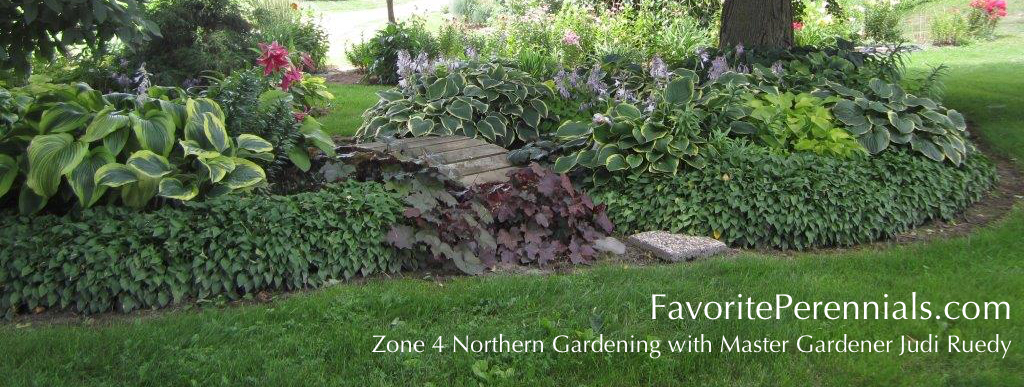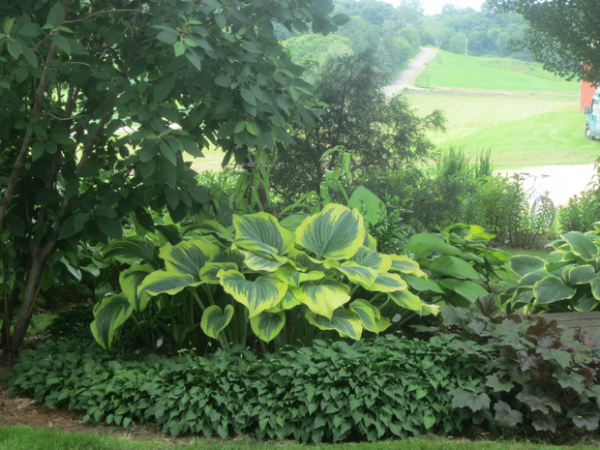Creative Ideas For Perennial Bed Borders Using Hostas
Create natural borders using small and miniature Hosta varieties. Find ideas and recommendations for designing your Zone 4 shade garden.
This is a follow-up to a post I wrote about earlier using Hostas as a border.
I have been asked many times about some of my perennial beds that have one variety of Hosta planted as a border and so this article is about some of my knowledge of beds with borders. I don’t feel with borders on Hosta beds that they have to go all around the whole bed, but can be part of the way and ending at a rock or another larger Hosta.
They can also intertwine between other Hostas too. Because I don’t always have enough of one variety to border the whole bed, I only use what I have at the time, and maybe plant them up to a wall or edge of something else.
Using Hostas as Flower Bed Borders
The photo below has a border of Vanilla Cream entwining through and contrasting with the darker greens in the bed, and Blue Mouse Ears in center front which is filling out real nice, and Touch of Class on the right edge of this bed.

The Touch of Class is indeed, true to its name. It is a sport of June. The leaves have a thick substance and it is a joy to grow. By September, there is no burning or no damage from insects. It lasts through the first couple of frosts also. Now, this also is in 3/4 shade so that helps with no burning or the frost in the fall. It may eventually be too large for a border on this bed, but the first 3 years were good. This is another Hosta that multiplies at a fast rate.

This Vanilla Cream Hosta border on the south side of the gazebo, was divided and transplanted in the fall of 2014. There were many, many plants as this multiplies readily, and so the divisions were quite large. This picture was taken at the end of June, 2015, and by the end of August, the plants had grown much more.
The Vanilla Cream entwines through the bed on the north, as well as on the left side of the gazebo, on the south , and makes a border there too. With a south west exposure, there may be some burning on these; however there are large shade trees that will help. I am going to try to water them more often to keep them from burning.
 The little border in the front of the bed is Blue Mouse Ears. I divided 3 large clumps just 1 year ago to make this border, and they are thriving. It doesn’t seem to matter that they are near the sidewalk in the winter with the snow and all. They are a sturdy Hosta and multiply fast, even faster than Tiny Tears. They are shorter and spread sideways and grow fast. The leaves have a heavy substance and bugs seem to stay away from them. There is the added bonus of nice purple flowers in early July.
The little border in the front of the bed is Blue Mouse Ears. I divided 3 large clumps just 1 year ago to make this border, and they are thriving. It doesn’t seem to matter that they are near the sidewalk in the winter with the snow and all. They are a sturdy Hosta and multiply fast, even faster than Tiny Tears. They are shorter and spread sideways and grow fast. The leaves have a heavy substance and bugs seem to stay away from them. There is the added bonus of nice purple flowers in early July.
On the above picture, back left is Montana Aureo marginata, Center is Majesty, and then a border of Tiny Tears.
This is the first border I ever tried (above) was with Tiny Tears Hosta. This is classified as a miniature because of the small leaf size. I purchased this Hosta about 25 years ago as a single plant and for the first few years kept it growing in a little clay pot in the ground summer and winter. As it got larger, I divided it and put it in the ground in a few different spots. They seemed to thrive.
It continued to grow and multiply and when I put it in a new bed with a dry creek bed and a bridge, I divided it and planted all those little plants along the edge about 2/3 of the way around the bed. It has been a very nice border, the plants mounding higher in the middle and lower on the edges.
About the second week of July I am rewarded with many, many dark purple flowers that last for 1-2 weeks, depending on the weather. After blooming I cut all the blossoms off and the plants still look nice. Tiny Tears does however, shut down in early September and start to go dormant. Here they are in 3/4 shade.
 Halcyon is another Hosta that I have used in a border, and in other articles on my site here, I talk about this sturdy Hosta. In the picture above these have been planted about 2 years but were large chunks of Hostas when I put them in the ground. Halcyon given 4 to 5 years gets to be a very large clump! This area by our Farm Sign is half in shade and half in full sun.
Halcyon is another Hosta that I have used in a border, and in other articles on my site here, I talk about this sturdy Hosta. In the picture above these have been planted about 2 years but were large chunks of Hostas when I put them in the ground. Halcyon given 4 to 5 years gets to be a very large clump! This area by our Farm Sign is half in shade and half in full sun.
The shade comes from large tall White Pine Trees that are over 100 years old. The Hostas have to compete with both the sun and shade as well as the roots of the trees. The soil is clay. You can see the difference in the color of the greens and the blues of the Halcyon. So far, they have done well here.
The ones on the south bank of the sign do burn somewhat, but not so much that I would take them out. Next summer I will post another picture of these and you will be able to see how much they have grown. The mulch on this bed is pine needles from the White Pines. It is a superb mulch for any perennial bed.
I had a question asked to me about using the old green Lancifolia for a border. Lancifolia have a nice floral display late in the season and long narrow green leaves. They make a nice mound for a shape and grow together quite fast. I guess I would say it would work at the edge of a bank pretty good but wouldn’t do it at the edge of a perennial bed as they are too big and too tall. I would suggest along the lawn/woods if you have a setting such as that. They are an old tough Hosta, but don’t like the sun too much.

The above picture has a border of Dew Drop that goes around to the house. The hosta on the right of the picture is Satisfaction.
The Hosta in the border is called Dew Drop that is a tiny little thing, with a very narrow white edge on small green leaves that will mound up in the center as they grow. They are also fast growers and multiply rapidly. They spread out to fill in the soil areas between the plants. This was taken the end of June and they are just starting to bloom.
Halcyon is probably the best Hosta for borders or any place. I have grown them in almost full sun and they had very little burning. They are not so blue in full sun however. They were grown in heavy soil in the center of the lawn, and not next to a building or sidewalk where the suns rays can be 10-15 degrees hotter when they reflect off other objects.
Halcyon Hosta is a blue and once mature is quite a specimen. It is elegant looking with the large blueish leaves.



Your flowerbeds are beautiful! I have always admired beds that have hostas as borders!
I planted a hosta in the front border where the afternoon sun gets things pretty warm till 8pm. The name is ‘June Fever’.and because of the sun and heat the leaves turned brown a bit and it lost it’ nice lime color.Should I leave it where it is or move it the shade at the back of the house.Also, could you please recommend another hosta for this area and one that doesn’t grow really huge,Thanks,Sharon
Hello Jake,
I have just in the past week or so posted a new article on the website on using Hostas as Borders in Perennial Beds so if you go into the Favorite Perennials site you can read what varieties I wrote about.
I have had June Fever for only 2 years now so don’t know a lot about how it will react to different conditions. But, June is an excellent Hosta and it is a sport of June so it should be a very good choice if it gets more shade.
The leaves burn because they need more water. Possibly new soil in the hole where it is planted too. And, of course, too much sun. In the shade the water doesn’t evaporate from the leaves so fast. I hope all this helps you out. Thank you for checking out my website!
Hi Judi,
Just had to add my two cents….just wonderful. I’ve always had a passion for Hosta, and they are my go to plant whenever I’m designing (or redesigning) my garden.
You have shown such a lovely selection of Hosta and have displayed them so beautifully, Kudos to you.
Thank you, Bobbi. Glad you found my site and it has been good information for you to use!
Hello Judi, Chuck here, also a Master Gardener Volunteer, I live in zone 2b but brag the nicest hostas in town. That is until last year when we cut down 9 large shade-giving trees from our yard. Suffering from sunburn the hostas took a hit, I have split and moved plants all over the yard, we will see how things evolve this year. For years I have told people about the giant hosta outside the Catholic church in Charlotown in the middle of a parking lot in full sun. Alot of my hostas came from Vessey’s PEI, but they do not have the sun tolerance of the aforementioned hosta. I am a first-time visitor to your site, but am very impressed, good job! growing a carrot can be tough to do in cold climates, the hostas give a feeling of accomplishment. Good gardening, Chuck
Hello Chuck, Thank you for finding my site. I have a sister in zone 3 but do not know anything about zone 2 at all! You probably have a shorter growing season but Hostas like the cold weather to rest in. I can’t explain the giant hosta in the middle of a parking lot! Some varieties do acclimate to more sun as they get older. Maybe the lot drains to that point so it has plenty of water? Most Hostas will do good in more sunny conditions if given enough water so they aren’t so stressed. Soil too is another important aspect of the whole growing thing. The giant must have what it needs for sure! Thank you for the nice compliment. I appreciate it! Have fun gardening! Judi